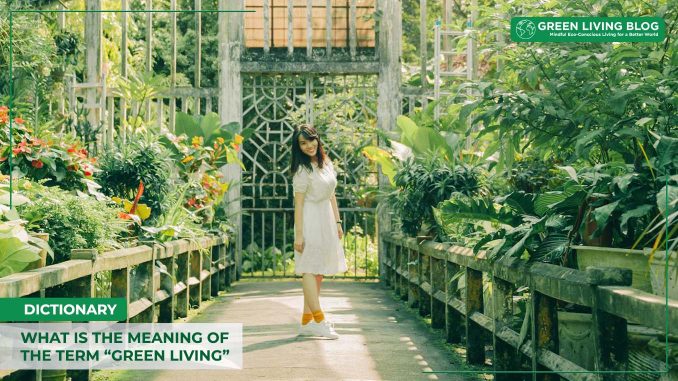
“Green living” refers to adopting lifestyle choices and practices that minimise environmental impact, promote sustainability, and conserve natural resources. This encompasses a wide range of activities, including reducing energy consumption, utilising renewable energy sources, minimising waste, conserving water, and supporting eco-friendly products and services.
Key Aspects of Green Living:

1. Energy Efficiency:
Implementing measures to reduce energy consumption, such as using energy-efficient appliances, insulating homes, and adopting smart home technologies.
2. Renewable Energy:
Transitioning to renewable energy sources like solar, wind, and hydroelectric power to reduce reliance on fossil fuels.
3. Waste Reduction:
Practising recycling, composting, and reducing single-use plastics to minimise waste sent to landfills.
4. Water Conservation:
Installing water-saving devices, fixing leaks promptly, and using water-efficient appliances to conserve water resources.
5. Sustainable Transportation:
Opting for public transport, cycling, walking, or electric vehicles to reduce carbon emissions from personal transportation.
6. Support for Eco-Friendly Products:
Choosing products made from sustainable materials, supporting local and organic agriculture, and purchasing from companies committed to environmental responsibility.
Green Living in the UK, London and Europe:
Lifestyle Changes for Environmental Reasons:
Between May and June 2023, approximately 86.5% of adults in Great Britain reported making changes to their lifestyle to address environmental issues. Specifically, 73.6% made some changes, while 12.8% made significant alterations. Women (91%) were more likely than men (81.7%) to adopt environmentally friendly practices. Source: ONS.
Consumer Attitudes Towards Sustainable Homes:
In 2022, about 80% of first-time homebuyers and 73% of second-time buyers in the UK expressed a likelihood of considering green homes in their purchasing decisions. Source: Statista.
Recycling Rates:
In 2022, the UK’s household waste recycling rate declined to 44% from 44.6% the previous year. England’s rate decreased to 43.4%, while Scotland saw a slight increase to 42.1%. Wales led with a 56.9% recycling rate, attributed to effective food waste collection services and proactive local authorities. Source: GOV.UK.
Green City Spaces:
London boasts over 35,000 acres of public green spaces, including more than 3,000 parks. Approximately 40% of Greater London comprises parks and green areas, underscoring the city’s dedication to providing residents with accessible natural environments. Source: Green City Times.
Adoption of Heat Pumps:
The transition to heat pumps in London has been gradual. A case study highlighted that retrofitting a London home with a heat pump and necessary insulation could cost around £17,000, with potential annual savings of over £800 on energy bills and a reduction of approximately 1,700 kg of CO₂ emissions. Source: Arxiv.
Statistics and Trends:
- The Mayor of London has set a target to supply 15% of the city’s energy from renewable, local sources by 2030, aiming to enhance energy efficiency and reduce carbon emissions. Source: Mayor of London, London Assembly.
- In 2023, renewable energy sources accounted for 24.5% of the European Union’s final energy consumption, marking a one percentage point increase from 2022. This growth is primarily driven by an uptick in renewable electricity supply. Source: European Environment Agency.
- In the third quarter of 2024, renewable sources contributed 50.5% of the UK’s electricity generation, an increase of 6.1 percentage points compared to the same period in the previous year. Source: Assets.Publishing.Service.
- The UK government aims to achieve net-zero greenhouse gas emissions by 2050, with a significant portion of this target relying on the transition to renewable energy sources. Source: UK Parliament.
- The EU has set a target of recycling 65% of municipal waste by 2035. Source: Statista.
Additional Research:
- Corporate Sustainability Reporting EU. Click here for more information.
- Leading Requirements for a More Sustainable Lifestyle 2024. Click here for more information.
- Greener Homes Report 2024. Click here for more information.
By embracing green living practices, individuals and communities contribute to environmental conservation, reduce their carbon footprint, and support the transition to a more sustainable future.
![]()
Author Profile

- Always on the hunt for the latest green living news, tips and stories, proudly sharing them with readers all around the world to make this planet a better place.
Latest entries
 Green Business NewsMarch 12, 2025WindsorPatania Architects’ game-changing Virtual Reality Education Project XR Lab takes Top Award
Green Business NewsMarch 12, 2025WindsorPatania Architects’ game-changing Virtual Reality Education Project XR Lab takes Top Award DictionaryFebruary 11, 2025What is the Meaning of the Term “Green Living”
DictionaryFebruary 11, 2025What is the Meaning of the Term “Green Living” Green News ReleasesJanuary 30, 2025Stand Up Pouches: What to Know about Flexible Packaging for Sustainable Brands
Green News ReleasesJanuary 30, 2025Stand Up Pouches: What to Know about Flexible Packaging for Sustainable Brands DictionaryJanuary 11, 2025What is the Meaning of the Term “Guest Post”
DictionaryJanuary 11, 2025What is the Meaning of the Term “Guest Post”





Leave a Reply
You must be logged in to post a comment.